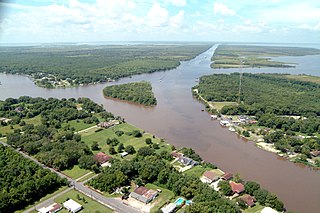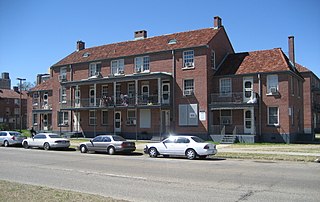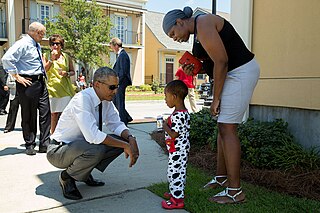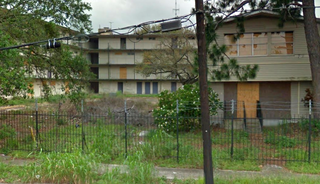| Part of a series on |
| Living spaces |
|---|
 |


The Housing Authority of New Orleans is a housing authority in New Orleans, Louisiana, tasked with providing housing to low-income residents.
| Part of a series on |
| Living spaces |
|---|
 |


The Housing Authority of New Orleans is a housing authority in New Orleans, Louisiana, tasked with providing housing to low-income residents.
Public housing in New Orleans has been subject to federal control for a number of years before Hurricane Katrina. These housing projects in New Orleans have also been home to important cultural contributions, such as the birth of Bounce music. [2] In 1936, the Louisiana Legislature passed the Housing Authority Act, allowing for the creation of the Housing Authority of New Orleans and paving the way for the city to participate in the national low-rent housing program. Some of the first developments broke ground between 1938 and 1940 over slums and old stores in the Tremé and Uptown area. The Lafitte, Magnolia, Calliope and St Bernard known as the big four, all opened in 1941 to black families. St. Thomas and the Iberville developments opened for whites in 1942. [3] In the 1950s the Florida and Desire developments opened in the 9th Ward neighborhoods with the Desire for blacks and Florida for whites. Families of the Desire claimed that the new project was run-down while the Florida was nicely built in good condition. Between 1961 and 1964 HANO construed two more housing projects for low-income black families. The Melpomene housing project opened in 1964 in Central City with the Fischer opening in 1965 in Algiers. Both projects contained a high-rise building and an elementary school. By the early 1970s, the projects had severely declined with crime and poor living conditions being the main problems. Residents complained to HANO and the state for funding but no money was funded to renovate the run-down developments. Certain projects were so bad police refused to enter them fearing for their lives.[ citation needed ] Other projects like the Lafitte remained peaceful and with very little crime due to neighborhood watch groups. Drugs like heroin played a major role in corruption as well as abandonment of law enforcement. Throughout the 1980s and 1990s violent crimes and murders made New Orleans projects one of the deadliest in the country with an average of 40% of the city's killings taking place in public housing projects. [4] In 1986, crime statistics complied by NOPD showed that generally in three housing projects considered the most dangerous -Desire, St. Thomas, Fischer, had the less police response from 911 dispatch. [5] In 1990, Housing Authority and the New Orleans Police Department was offered 1 million in federal grants for police sub stations in the city's most troubled developments. The substations were planned to reduce crime mainly for the St. Thomas and Fischer developments, which at the time was leading the city in violent crimes. [6] However plans for the substations did not go through and in 1993, New Orleans tailed 395 killings. The death toll was more per capita than in the country's five largest cities; 99 of New Orleans' slayings were on public housing property. Even in Chicago, with three times the number of public housing residents, the housing authority recorded half as many murders as New Orleans did in its developments [7] After Hurricane Katrina many of HANO's residents was forced to vacate their apartments due to water damage although many buildings sustained only minor damage. At the time of the storm, the Housing Authority of New Orleans was serving 14,129 families. Out of those, 64 percent, or 8,981, received vouchers, while 36 percent, or 5,148, were in public housing. After families moved out many projects were demolished and converted into mixed-income townhouses. Between 2005 and 2013 HANO demolished all of its properties with only a couple of buildings preserved as historic landmarks. [8]

In June 2011, Senate Bill 78 of the Regular Louisiana Legislative Session, introduced by Senator Edwin R. Murray of New Orleans and then HANO Chief Mitchel S. J. Dussett created the Housing Authority of New Orleans Police Department. The statute gave the officers the same authority as that of the Louisiana State Police. Currently the department employs full-time commissioned police officers who are primarily responsible for providing protective services within and around the public housing developments. In addition, these officers provide assistance to the New Orleans Police Department on a daily basis by answering calls for service in and around the developments. The officers employed by HANO have the authority to effect arrests, issue traffic citations, issue municipal summons and enforce municipal, state and federal laws.
On June 27, 2006, a class action lawsuit was filed by displaced residents of New Orleans public housing to challenge the plan of the United States Department of Housing and Urban Development (HUD) to reduce the number of public housing units in the city from 5,100 before Hurricane Katrina to only 2,000 units.
The New Orleans city council voted unanimously on December 20, 2007, to allow HUD to destroy 4,500 units of low-income housing. HUD planned to replace the units with mixed-income housing. The city council took this decision despite protests that were at times violent. [11] [12] [13] [14]
No direct public housing racial statistics are available for the City of New Orleans however, racial data from HUD's Resident Characteristics Report, [15] as of December 31, 2013, indicate that of the 2,078 public housing units in Orleans Parish, 1,974 (95%) of the occupants are black, or about 1% of the Parish's overall black population of 206,985 (60.2%). The corresponding HUD statewide figures for Louisiana's 21,708 public housing units show that 17,366 (80%) of the occupants are black, or, again, about 1% of Louisiana's black population of 1,498,652 (32.4%). Blacks occupy 874,000 (46%) of the 1,900,000 public housing units nationwide, or about 2% of the 39,684,125 (12.5%) black people in America.

New Orleans is a consolidated city-parish located along the Mississippi River in the southeastern region of the U.S. state of Louisiana. With a population of 383,997 according to the 2020 U.S. census, it is the most populous city in Louisiana and the French Louisiana region; the third-most populous city in the Deep South; and the twelfth-most populous city in the southeastern United States. Serving as a major port, New Orleans is considered an economic and commercial hub for the broader Gulf Coast region of the United States.

Jefferson Parish is a parish in the U.S. state of Louisiana. As of the 2020 census, the population was 440,781. Its parish seat is Gretna, its largest community is Metairie, and its largest incorporated city is Kenner. Jefferson Parish is included in the Greater New Orleans area.

Jean Lafitte is a town on Bayou Barataria in the U.S. state of Louisiana. Located in Jefferson Parish, it is named after the privateer Jean Lafitte. The population was 1,809 at the 2020 census. It is part of the New Orleans–Metairie–Kenner metropolitan statistical area.

Algiers is a historic neighborhood of New Orleans and is the only Orleans Parish community located on the West Bank of the Mississippi River. Algiers is known as the 15th Ward, one of the 17 Wards of New Orleans. It was once home to many jazz musicians and is also the second oldest neighborhood in the city.
HOPE VI is a program of the United States Department of Housing and Urban Development. It is intended to revitalize the most distressed public housing projects in the United States into mixed-income developments. Its philosophy is largely based on New Urbanism and the concept of defensible space.

Malik Rahim is an American housing and prison activist based since the late 1990s in the New Orleans area of Louisiana, where he grew up. In 2005 Rahim gained national publicity as a community organizer in New Orleans in 2005 to combat the widespread destruction in the aftermath of Hurricane Katrina; there he co-founded the Common Ground Collective.

St. Thomas Development was a notorious housing project in New Orleans, Louisiana. The project lay south of the Central City in the lower Garden District area. As defined by the City Planning Commission, its boundaries were Constance, St. Mary, Magazine Street and Felicity Streets to the north; the Mississippi River to the south; and 1st, St. Thomas, and Chippewa Streets, plus Jackson Avenue to the west. In the 1980s and 1990s, St. Thomas was one of the city’s most dangerous and impoverished housing developments. It made national headlines in 1992 after the deadly shooting of Eric Boyd. In 1982 Helen Prejean moved into the St. Thomas development in order to live and work with the poor. While there, Sister Helen began corresponding with Patrick Sonnier, who had been sentenced to death for the murder of two teenagers. After witnessing the executions, she sat down and wrote a book, Dead Man Walking. The book inspired the 1995 film Dead Man Walking. In 1998 the project was demolished and replaced with mixed income "River Garden."

The Magnolia Projects, later the C. J. Peete Public Housing Development, was one of the Housing Projects of New Orleans. The area has been more recently renamed Harmony Oaks as part of a complete HOPE VI redevelopment of the property. As a housing project, it was among the largest, housing approximately 2,100 people. It is also home to numerous hip-hop artists and is located in the part of uptown New Orleans known as Central City within the 11th Ward of New Orleans. It was bounded by Louisiana Avenue, South Claiborne Avenue, La Salle Street and Washington Avenue. The Magnolia Projects was made famous by rappers such as Juvenile, Soulja Slim, and Magnolia Shorty. At its height, the Magnolia projects had 1403 units.
Desire Projects was a housing project located in the Ninth Ward of New Orleans, Louisiana. These projects were the largest in the nation and consisted of about 262 two-story brick buildings, containing about 1,860 units across 98.5 acres of land. The overall conditions of the projects were deplorable from the moment they were put into place in the later part of the 1950s. The projects were meant to serve the large number of underprivileged African-American residents in the New Orleans area. Soon it became a place of despair, and Desire eventually evolved into a dark no-man's land, leaving many residents infested with problems and little or no help from the government. Located in a cypress swamp and dumping ground, Desire was known as the poorest housing development in New Orleans—it was bordered by railroad tracks, the Mississippi River, the Industrial Canal and a corridor of industrial plants.
Florida Avenue Projects or Florida Projects is a public housing project in the city of New Orleans. The development was built in 1946 on an 18.5-acre tract of land bounded by Florida Avenue and North Dorgenois, Mazant and Gallier streets in the Upper 9th Ward. It contained 47 two- and three-story brick buildings, arranged around courtyards and largely isolated from the rest of the community, for a total of 734 units housing 1,297 residents. Originally built for whites, it was later desegregated and by the 1970s was becoming predominantly a black project. In the mid-1990s, Florida and nearby Desire Projects were dubbed the most violent housing projects in the nation. In 1994, Florida recorded the highest homicide rate of all HANO developments, with 26 slayings, surpassing the 13 killings in Desire which previous held the highest record a year before. The majority of the Florida killings in 1994 were fueled by drug wars, specifically between the notorious Hardy Boys and the Poonie Crew. The homicide spike in Florida and Desire contributed to New Orleans being dubbed "the nation's murder capital". That year the city's homicide rate reached 424, 47 of those killings occurring in HANO developments.

The Melpomene Projects, officially called the Gustavo Apartments or TheGuste Homes, and colloquially The Melph, are a housing complex located in the Central City neighborhood of New Orleans.

The Lafitte Projects were one of the Housing Projects of New Orleans and were located in the 6th Ward of New Orleans Treme neighborhood. It was one of Downtown New Orleans' oldest housing developments and had many associated problems before being severely flooded and damaged during Hurricane Katrina in 2005. The project made national headlines after the gruesome murder of Thomas May who burned to death in the project in 1994. By a Department of Housing and Urban Development (HUD) decree, the projects were demolished and redeveloped as affordable, mixed-income housing. The redevelopment effort was charged with replacing every demolished unit. The large housing project was left mostly vacant following evacuations after the extensive flooding from Hurricane Katrina. Heated arguments have surrounded the demolition of the project, as some longtime residents wanted them renovated.

Iberville Projects was a neighborhood in the city of New Orleans and one of the low-income Housing Projects of New Orleans. The Iberville was the last of the New Deal-era public housing remaining in the city. Its boundaries were St. Louis Street, Basin Street, Iberville Street, and North Claiborne Avenue. It is located in the 6th ward of downtown New Orleans, on the former site of the Storyville district. The area has recently been redeveloped into a modernized apartment complex called the Bienville Basin Apartments.

The William J. Fischer Housing Development, better known as the Fischer Projects, was a housing project in Algiers, New Orleans, Louisiana, United States. It was known notoriously for a series of high-profile murders in the 1970s and 1980s. It was the last conventional public housing development constructed in New Orleans, and one of the first to begin demolition. It originally consisted of a 13-floor high-rise and fourteen 3-floor units. The area has been undergoing redevelopment since about 2004 and currently none of the original low-rise buildings remain. The development is located along Whitney Avenue in the Algiers area of the city's west bank, which is part of the 15th Ward and is named for William J. Fischer who served as chairman of HANO in the 1950s. The property is now converted to a small low-income housing development.

People from the Gulf States region in the southern United States, most notably New Orleans, Louisiana, were forced to leave their homes because of the devastation brought on by Hurricane Katrina in 2005 and were unable to return because of a multitude of factors, and are collectively known as the Gulf Coast diaspora and by standard definition considered internally displaced persons. At their peak, hurricane evacuee shelters housed 273,000 people and, later, FEMA trailers housed at least 114,000 households. Even a decade after Hurricane Katrina, many victims who were forced to relocate were still unable to return home.

New Faubourg Lafitte is a residential development in New Orleans, Louisiana, U.S. It largely occupies the area formerly filled by the since demolished Lafitte Projects public housing.

DeGaulle Manor was a low-income public housing complex in the Algiers neighborhood of New Orleans. The apartment complex was known for crime and was one of the oldest and most troubled apartment complexes in the city before being shut down in 2012. It later became a dumping ground for trash and in 2014, became a work of art as it was transformed into a graffiti display.
The B. W. Cooper Public Housing Development, also known as The Calliope Projects, was a neighborhood of the city of New Orleans and one of the housing projects of New Orleans. This project of New Orleans gained notoriety for its extremely high violent crime rate. It was demolished in 2014 and replaced with newer, mixed-income apartment buildings.
Behrman also known as "Behrman Heights", is a community located in Algiers, New Orleans It was named after popular New Orleans mayor Martin Behrman, and is nestled south of the US Naval Support neighborhood and north of Tall Timbers/Brechtel, flanked on the west by Fischer Housing Development and Whitney, and on the east by Old Aurora.
Christopher Homes, also known as Christopher Park Homes was a scattered-site housing complex in the Algiers neighborhood, operated by HANO, with originally 250 townhouse style units which opened in 1971. It would be celebrated as the nation's first rent-to-own public housing. Since the complex first opened, disgusted homeowners have been driven away by Formosan termites and rotting wood left under the complex's flat roofs. Families also fled in the 1980s after a ceiling collapsed on a girl's head and a roof leak caused an electrical short that set a boy's bed on fire. Due to the poor living conditions, pests became a major problem for residents living in the Christopher Homes. There had been numerous reports about large rodents known as "Nutria Rats" roaming though the buildings and outside, but HANO refused to get the buildings fumigated.
{{cite web}}: Check |url= value (help)CS1 maint: numeric names: authors list (link)